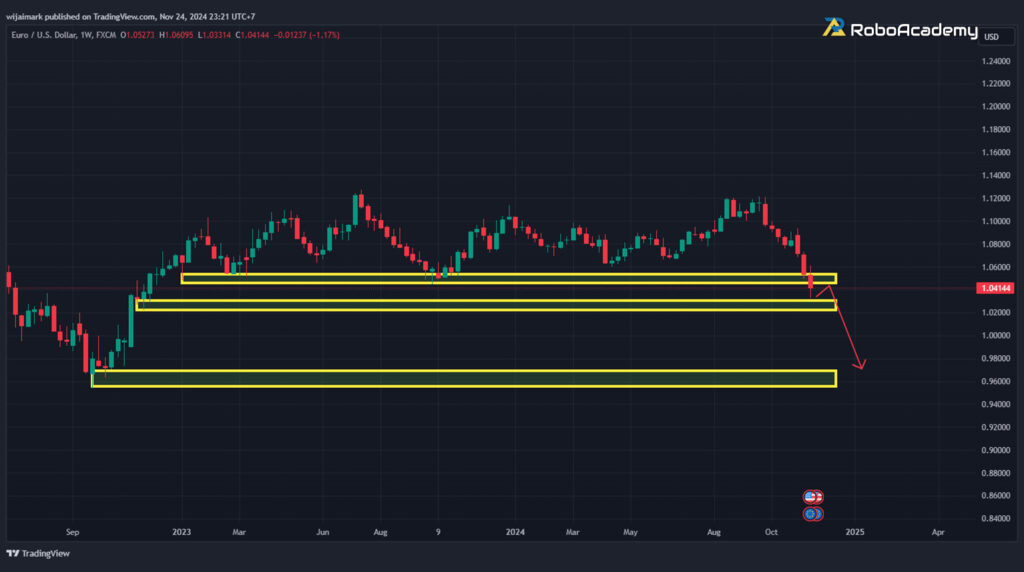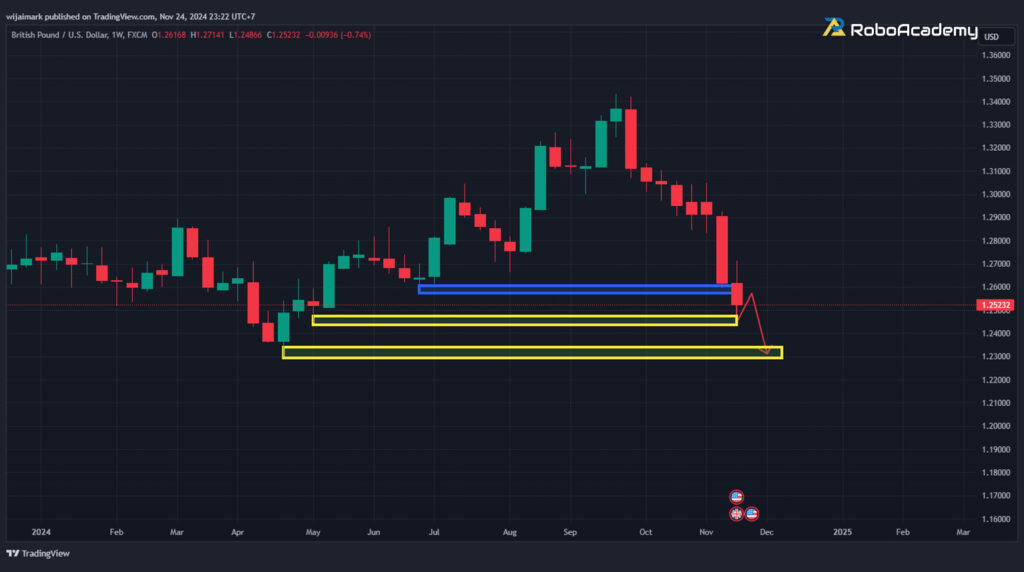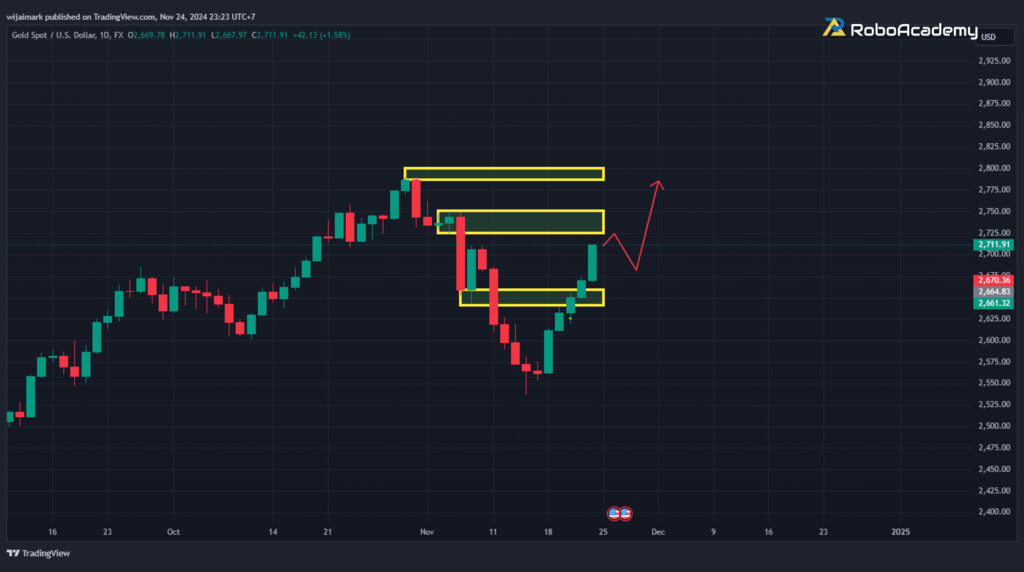Fundamental & Technical Analysis by Coach Mark RoboAcademy during 25 – 29 November 2024
Hello everyone, welcome to the weekly analysis of currency pairs EUR/USD, GBP/USD, and XAU/USD for the fifth week of November, from 25 – 29 November 2024.
EUR/USD, “Euro vs US Dollar”

Fundamental Analysis
Significant Economic Events Impacting EUR/USD This Week:
European Economic Data:
- German Ifo Business Climate Index (November 25): This index reflects the level of business confidence in Germany, the largest economy in the Eurozone. If the figure comes in higher than expected, it could support the euro. However, if it’s lower than expected, it may put pressure on the euro.
- Q3 GDP Estimates for Germany and the Eurozone (November 26): GDP is a key indicator of economic growth. If the figures reflect strong growth in the Eurozone, it may help support the euro. However, if they come in below expectations, it could lead to a weaker euro.
- Preliminary German Consumer Price Index (CPI) (November 29): Germany’s CPI is an indicator of inflationary pressures. If it comes in higher than expected, it could support the euro as it might prompt the European Central Bank (ECB) to reconsider its monetary policy stance.
U.S. Economic Data:
- U.S. Case-Shiller Home Price Index (November 26): This index reflects the state of the real estate market in the U.S. If home prices continue to rise, it could help support the strengthening of the U.S. dollar.
- U.S. Durable Goods Orders (November 27): If durable goods orders increase more than expected, it would indicate strength in the U.S. manufacturing sector, potentially supporting the U.S. dollar. However, if the numbers come in below expectations, the dollar could weaken.
- U.S. Conference Board Consumer Confidence Index (November 27): Higher-than-expected consumer confidence figures could have a positive impact on the U.S. dollar. Conversely, if the numbers decline, the dollar may weaken.
- U.S. Market Closure for Thanksgiving Day (November 28): The U.S. market closure could reduce volatility in the EUR/USD pair, with the market likely moving based on European factors.
- U.S. Pending Home Sales (November 29): Pending home sales reflect activity in the real estate market. If sales increase, it could support the U.S. dollar and put pressure on the euro.
Technical Analysis
The price has confirmed a close below a key support level on the weekly timeframe, which is a clear signal that there is a high likelihood of further downside movement. This is because closing below this level typically reflects strong selling pressure.
It is recommended to look for opportunities to enter a Sell position when the price retraces upwards. The next potential target to consider is the 1.03000 level, which could serve as a point where the price may experience further downward movement.
GBP/USD, “Great Britain Pound vs US Dollar”

Fundamental Analysis
Significant Economic Events Impacting GBP/USD This Week:
U.K. Economic Data:
- U.K. CBI Business Optimism Index (November 25): This index reflects business sentiment in the U.K. If the figures come in higher than expected, it could support the British pound. However, if the figures fall below expectations, it may put downward pressure on the pound.
- Q3 GDP Estimates for the United Kingdom (November 26): This data indicates the economic performance of the previous quarter. If the GDP growth exceeds expectations, it could help strengthen the British pound. On the other hand, if the numbers are weaker than expected, the pound may weaken.
- U.K. Nationwide House Price Index (November 29): A rise in house prices could signal confidence in the economy, which may support the British pound.
U.S. Economic Data:
- U.S. Case-Shiller Home Price Index (November 26): If home prices in the U.S. continue to rise, it will reflect the strength of the U.S. real estate market and may support the U.S. dollar.
- U.S. Durable Goods Orders (November 27): An increase in durable goods orders would indicate strength in the U.S. manufacturing sector, potentially supporting the U.S. dollar and putting pressure on the British pound. However, if the numbers fall short of expectations, the dollar may weaken.
- U.S. Conference Board Consumer Confidence Index (November 27): Higher-than-expected consumer confidence could strengthen the U.S. dollar. On the other hand, a decline in confidence may provide support for the British pound.
- U.S. Market Closure for Thanksgiving Day (November 28): The market closure in the U.S. may reduce volatility in the GBP/USD pair, with market movements likely influenced by factors from the United Kingdom.
- U.S. Pending Home Sales (November 29): An increase in pending home sales could support the U.S. dollar, while a decline in sales may provide support for the British pound.
Technical Analysis
The price continues to decline and has broken through all key support levels, which is a clear sign that there is a high probability of further downside.
It is recommended to look for opportunities to open sell positions in line with the ongoing price movement. The next price target to watch is the support zone around 1.24300, which may serve as a potential testing point where a pullback could occur in the next phase.
XAU/USD, “Gold vs US Dollar”

Fundamental Analysis
Significant Economic Events Impacting XAU/USD This Week:
Economic Data Related to Gold:
- German Ifo Business Climate Index (November 25): If the business confidence index in Germany decreases, it will reflect concerns about the Eurozone economy, which could increase demand for gold as a safe-haven asset.
- Eurozone Q3 GDP Estimates (November 26): This data will provide an overview of the Eurozone’s economy. If it shows signs of slowing growth, it could support gold prices due to concerns about the global economic situation.
- U.S. Case-Shiller Home Price Index (November 26): If home prices in the U.S. continue to rise, it will support the U.S. dollar, which may put pressure on gold prices. However, if the data comes in lower than expected, gold may rise.
- U.S. Durable Goods Orders (November 27): If durable goods orders exceed expectations, it will signal strength in the U.S. economy, which could pressure gold prices. However, if the orders decline, gold may rise.
- U.S. Conference Board Consumer Confidence Index (November 27): An increase in consumer confidence could strengthen the U.S. dollar and put pressure on gold prices. However, if confidence decreases, gold could receive support.
- U.S. Market Closure for Thanksgiving Day (November 28): The market closure may reduce volatility in gold prices, with gold potentially moving in line with other market factors.
- Preliminary German CPI (November 29): If Germany’s CPI comes in higher than expected, it could boost gold prices due to concerns over inflation in the region.
- U.S. Pending Home Sales (November 29): An increase in pending home sales could support the U.S. dollar and put pressure on gold prices. However, if the data comes in lower than expected, gold may rise.
Technical Analysis
Last week, the price has been moving upwards throughout the week and is approaching a test of the resistance at the 2725-2730 level. If the price tests the resistance and then pulls back, you can consider looking for a follow-up buy opportunity when the price retests various support levels in smaller timeframes, with the expectation that the price will continue to move upward. Additionally, the psychological support level at 2700 can be used. If the price consolidates and holds above this level, there is a chance the price will move upward again.
Disclaimer: This article is solely an analysis from the coach at RoboAcademy and is not intended as investment advice in any way. Investing is risky. Investors should study the information before making investment decisions.


